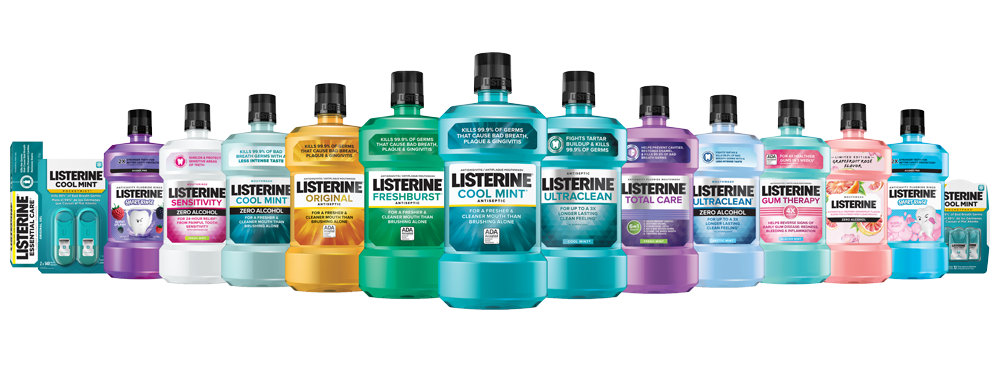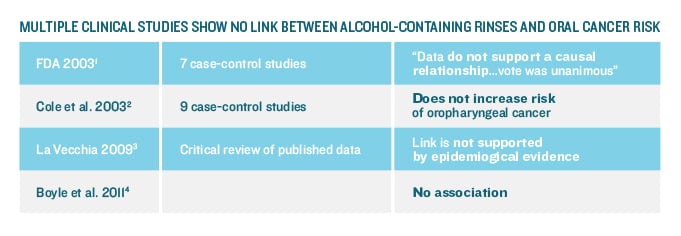


Licensed professionals can receive the latest Listerine clinical information and patient resources.

ALCOHOL-CONTAINING RINSES HAVE NO LINK TO ORAL CANCER.
There are some people who still believe that alcohol-containing mouthrinses may increase the risk of developing oropharyngeal cancer, or OPC. As an oral healthcare professional, you’re most likely aware that this is just a myth. However, you may not be familiar with the wealth of evidence that effectively dispels this myth.1-4
To be as informed as possible about this topic, you may want to take a look at the evidence presented below—so you can most effectively address any potential concerns or questions your patients may express to you.
In fact, quite a few clinical studies resulted in similar conclusions:
Food and Drug Administration. 2003 Federal Register. 2003;68(103):32,232-32,2871:
- FDA subcommittee reviewed 7 case-control studies
- Conclusion: “Data do not support a causal relationship between the use of alcohol-containing mouthrinses and oral cancer. The vote was unanimous...”
Cole et al. Journal of the American Dental Association. 2003;34(8):1079-10872:
- Review of 9 case-control studies, published in JADA
- Finding: Alcohol-containing mouthwash does not increase risk of oropharyngeal cancer
La Vecchia et al. Oral Oncology. 2009;45:198-2003:
- Critical review of published data
- Finding: Link between mouthwash use (specifically alcohol-containing mouthwash) and oral cancer is not supported by epidemiological evidence
Boyle et al. Oral Surgery, Oral Medicine, Oral Pathology, Oral Radiology, and Endodontology. 2011; 112;(6):e1304:
- Finding: No association between the use of mouthwash containing alcohol and oral cancer risk

Alcohol: How an inactive ingredient delivers the active ingredients.
It’s also important to note that, while alcohol is an inactive ingredient, it actually plays a very important role in the effectiveness of essential-oil-containing mouthrinses such as LISTERINE® Antiseptic:
- It acts as a vehicle for delivering the active ingredients, by enabling the essential oils to penetrate plaque biofilm and bacterial communities
- It also acts as a solvent to help solubilize the ingredients
- The delivery of these essential oils is integral to reducing plaque and gingivitis5
Recommend with confidence.
With the above evidence, it’s more than clear that there is no credible link between alcohol-containing mouthrinses and oral cancer. And, with more than 30 long-term clinical trials examining its safety and efficacy, no other over-the-counter (OTC) mouthwash brand in the world has been tested as extensively as LISTERINE® Antiseptic.6 Most importantly, armed with this information you can feel confident when recommending a LISTERINE® product to your patients, including the most skeptical among them.
For further information on the overall proven safety and tolerability of LISTERINE® mouthrinses, please click here.
We hope you found this article of value.
SAFETY AND TOLERABILITY.
With over 30 long-term clinical trials, LISTERINE® Antiseptic is the most extensively tested OTC mouthwash.
CLINICAL STUDIES.
Explore a wealth of evidence about the safety and efficacy of LISTERINE® mouthrinses.
Alcohol and Safety Footnotes
References:
1. Food and Drug Administration. Oral health care drug products for over-the-counter human use; antigingivitis/antiplaque drug products; establishment of a monograph; proposed rules. Part III. Federal Register. 2003;68(103):32,232-32,287. 2. Cole P, Rodu B, Mathisen A. Alcohol-containing mouthwash and oropharyngeal cancer: a review of the epidemiology. J Am Dent Assoc. 2003;134:1079-1087. 3. La Vecchia C. Mouthwash and oral cancer risk: an update. Oral Oncol. 2009;45(3):198-200. 4. Boyle P, Gandini S, Boffetta P, Negri E, La Vecchia C. Mouthwash use and oral cancer risk: quantitative meta-analysis of epidemiologic studies. Oral Surg Oral Med Oral Pathol Oral Radiol Endod. 2011;112(6):e130. 5. Lamster IB, Alfano MC, Seiger MC, Gordon JM. The effect of LISTERINE® Antiseptic on reduction of existing plaque and gingivitis. Clin Prev Dent. 1983;5:12-16. 6. Data on file, Johnson & Johnson Consumer Inc.





All Fields required, unless otherwise indicated
Personal Information
Step 1
Will be used as your user name
By submitting your information above, you agree that the information you provide will be governed by our site's Privacy Policy.